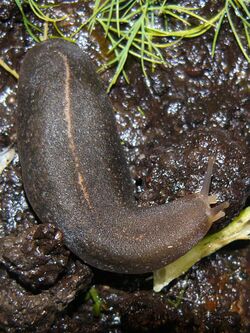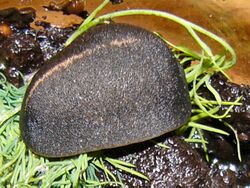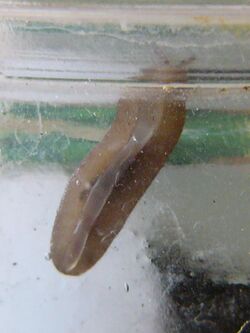Biology:Laevicaulis alte
| Laevicaulis alte | |
|---|---|

| |
| Scientific classification | |
| Domain: | Eukaryota |
| Kingdom: | Animalia |
| Phylum: | Mollusca |
| Class: | Gastropoda |
| Subclass: | Heterobranchia |
| Order: | Systellommatophora |
| Family: | Veronicellidae |
| Genus: | Laevicaulis |
| Species: | L. alte
|
| Binomial name | |
| Laevicaulis alte (Férussac, 1822)
| |
| Synonyms[1] | |
| |
Laevicaulis alte, or the tropical leatherleaf, is a species of tropical land slug, a terrestrial pulmonate gastropod mollusk in the family Veronicellidae, the leatherleaf slugs.
Description
Laevicaulis alte is a round, dark-coloured slug with no shell, 7 or 8 cm (2.8 or 3.1 in) long. Its skin is slightly tuberculated. The central keel is beige in colour.
This slug has a unique, very narrow foot; juvenile specimens have a foot 1 mm (0.039 in) wide and adult specimens have a foot that is only 4 or 5 mm (0.16 or 0.20 in) wide.
The tentacles are small, 2 or 3 mm (0.079 or 0.118 in) long, and they are only rarely extended beyond the edge of the mantle.
Parasites
This slug is an intermediate host for Angiostrongylus cantonensis, the rat lungworm, a round worm, the most common cause of eosinophilic meningoencephalitis.[2]
Predators
Laevicaulis alte is eaten by the frog Rana tigrina.[2]
Distribution
The species is probably indigenous to Africa, both western Africa and eastern Africa, particularly Tanzania.[3]
It has been introduced and has become an invasive species[4] in the following areas:
- Southern Asia
- Pratas Island, Taiwan[5]
- United States (Hawaii)[6]
- Islands in the Indian Ocean
- Australia (since 1889)
- Samoa
The species is already established in the USA, and is considered to represent a potentially serious threat as a pest, an invasive species which could negatively affect agriculture, natural ecosystems, human health or commerce. Therefore, it has been suggested that this species be given top national quarantine significance in the USA.[7]
Habitat
Laevicaulis alte lives in dry areas, mostly at lower altitudes.[citation needed]
Life cycle
The slug hatches from eggs. Laevicaulis alte has several adaptations for living in dry conditions: a rounded shape with as small as possible surface area, and a narrow foot to reduce evaporation.
Juvenile specimens search for food nearly always at night, and stay buried in the soil during the day. Larger specimens are active during the day sometimes. The slug can grow up from 0.5 cm (0.20 in) to approximately 4 cm (1.6 in) in length in 7 months.
References
- ↑ "Laevicaulis alte". Species. GBIF. http://www.gbif.org/species/2293764.
- ↑ 2.0 2.1 "Christoph Högger - Antagonists of Slugs and Snails". http://homepage.sunrise.ch/mysunrise/choegger/Slugs/Antagonists.html.
- ↑ Rowson B., Warren B. H. & Ngereza C. F. (2010). "Terrestrial molluscs of Pemba Island, Zanzibar, Tanzania, and its status as an "oceanic" island". ZooKeys 70: 1-39. doi:10.3897/zookeys.70.762
- ↑ "Laevicaulis alte Laevicaulis alte (Ferussac)". http://www.invasive.org/browse/subimages.cfm?sub=10951.
- ↑ Wu S.-P., Hwang C.-C., Huang H.-M., Chang H.-W., Lin Y.-S. & Lee P.-F. (2007). "Land Molluscan Fauna of the Dongsha Island with Twenty New Recorded Species". Taiwania 52(2): 145–151. Original.
- ↑ "Comprehensive Report Species - Laevicaulis alte". http://www.natureserve.org/explorer/servlet/NatureServe?searchName=Laevicaulis+alte.
- ↑ Cowie R. H., Dillon R. T., Robinson D. G. & Smith J. W. (2009). "Alien non-marine snails and slugs of priority quarantine importance in the United States: A preliminary risk assessment". American Malacological Bulletin 27: 113–132. PDF
External links
- articles at PubMed
- Distribution in Australia
- Distribution in United States
- In English and in Chinese
Images
- Drawing of ventral part of body, photo (In Japanese)
- Laevicaulis alte at Samoan Snail Project
- Photo (Japanese)
- Photo (Japanese)
- Photo (Japanese)
- Photo (Japanese)
Genome
Wikidata ☰ Q3170495 entry
 |



